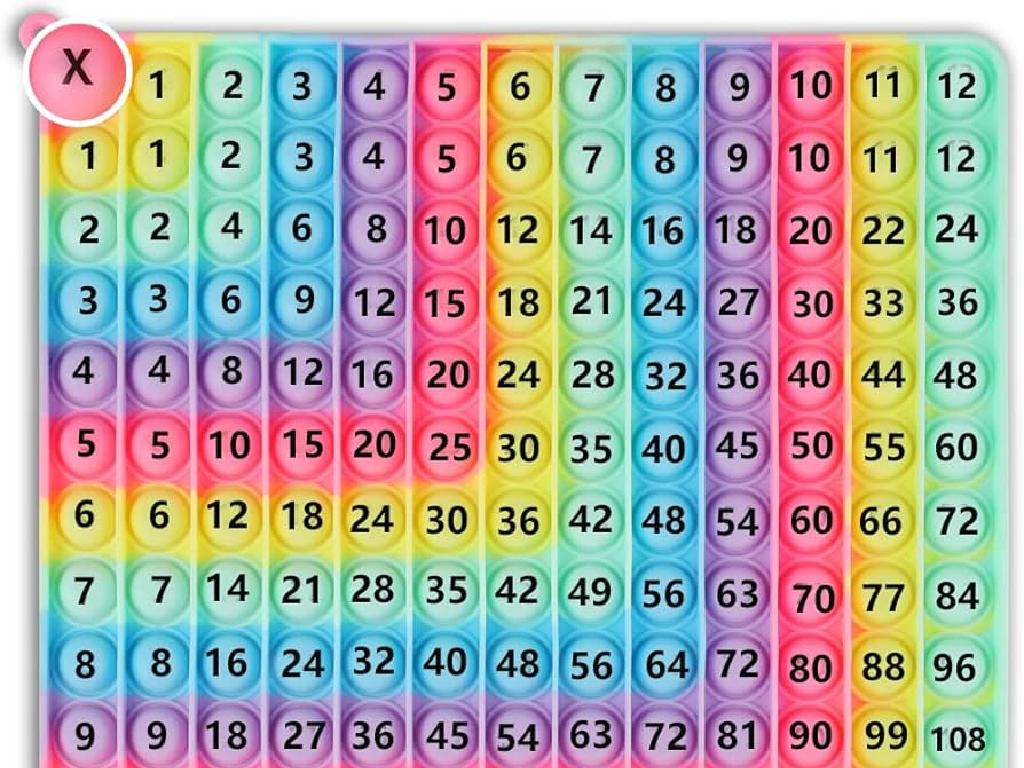Add And Subtract Decimals: Word Problems
Subject: Math
Grade: Seventh grade
Topic: Operations With Decimals
Please LOG IN to download the presentation. Access is available to registered users only.
View More Content
Introduction to Decimals
– Reviewing decimal concepts
– Decimal places: tenths to thousandths
– Tenths (0.1), Hundredths (0.01), Thousandths (0.001)
– Decimals in everyday life
– Money, measurements, and statistics
– Practice with real-world problems
– Solve problems involving purchases and measurements
|
This slide is aimed at refreshing students’ understanding of decimals and their place values. Begin with a brief review of what decimals are and how they are used to represent fractions and numbers less than one. Emphasize the importance of place value by discussing tenths, hundredths, and thousandths, and how each position represents a division by ten from the previous one. Provide relatable examples such as money (dollars and cents), measurements (meters and centimeters), and statistics (batting averages, interest rates) to illustrate how decimals appear in daily life. Conclude with an activity where students solve word problems that involve adding and subtracting decimals, such as calculating total costs of items or determining the difference in lengths. This will help them apply their knowledge to practical situations and reinforce their understanding of decimal operations.
Adding Decimals: Step-by-Step
– Guide to adding decimals
– Place the numbers so that the decimal points are in a vertical line
– Align decimal points
– Ensure all decimal places are aligned before adding
– Example: Item prices addition
– Add the cost of a pencil $1.50 and a notebook $2.75
– Practice with real-life problems
|
This slide introduces students to the process of adding decimals, a key skill in handling money and measurements. Start by explaining the importance of aligning decimal points, which ensures accuracy in addition. Use the example of adding prices of items like a pencil and a notebook to demonstrate real-world application. Emphasize that the same principles apply regardless of the context, whether adding prices, weights, or distances. Encourage students to practice with various word problems to solidify their understanding and prepare them for more complex operations with decimals.
Subtracting Decimals: Mastering Precision
– Accurate decimal subtraction
– Subtract numbers as if they’re whole numbers, ensure decimals are aligned vertically
– Align decimal points
– Decimal points must be directly above each other before subtracting
– Example: Purchase change calculation
– If an item costs $5.75 and you pay with $10, how much change do you get?
|
This slide focuses on teaching students the correct method to subtract decimals, emphasizing the importance of aligning decimal points. Start by explaining that the process is similar to subtracting whole numbers but requires careful placement of decimals. Use the example of calculating change to demonstrate a practical application of this skill. Have students practice with similar word problems, ensuring they align decimal points to maintain accuracy. This reinforces the concept and prepares them for real-world scenarios where they might need to use this skill.
Adding Decimals in Word Problems
– Read the problem thoroughly
– Understand the story and what is asked
– Find the decimals to add
– Highlight or underline the numbers with decimals
– Work through a sample problem
– Example: If a drink is $1.75 and a sandwich is $2.50, how much is the total?
– Discuss solution steps
– Add $1.75 + $2.50 to find the total cost
|
This slide is aimed at helping students tackle word problems involving the addition of decimal values. Start by emphasizing the importance of reading the problem carefully to understand the context and what is being asked. Teach students to identify and highlight the decimal values that need to be added. Walk through a sample word problem as a class, demonstrating how to set up the addition and calculate the sum. Discuss each step taken to solve the problem and ensure students understand the process. Encourage students to ask questions and try similar problems on their own to reinforce the concept.
Subtracting Decimals: Word Problems
– Comprehend the problem statement
– Read carefully to grasp what’s being asked
– Determine the decimals to subtract
– Identify the numbers and their place value
– Pair up for a group activity
– Work together to tackle a subtraction problem
– Solve and discuss the solution
– Share your methods and answer with the class
|
This slide is aimed at guiding students through the process of solving word problems that involve subtracting decimals. Start by ensuring students understand the importance of carefully reading the problem to fully comprehend what is being asked. Emphasize the need to identify which numbers in the problem are to be subtracted, paying close attention to their place values. The group activity should involve pairs of students working together to solve a provided word problem, encouraging collaboration and discussion. After solving, each pair will explain their approach and solution to the class, fostering a deeper understanding through peer learning. For the activity, prepare a set of diverse word problems that require decimal subtraction, ensuring a range of difficulties to cater to different skill levels within the class.
Decimal Operations: Practice and Review
– Solve addition/subtraction decimal problems
– Use precise decimal placement for accuracy
– Exchange worksheets for peer review
– Offer constructive feedback on classmates’ work
– Discuss challenges with the class
– Share difficulties and misconceptions openly
– Learn from peer feedback
– Apply feedback to understand mistakes
|
This slide outlines the class activity focused on practicing decimal addition and subtraction through individual work and peer review. Students will first work on a set of problems independently, ensuring they align decimal points and handle place values correctly. After completing their work, they will swap their worksheets with a peer for review, providing an opportunity for collaborative learning and reinforcing the concept of decimals. Encourage students to discuss any challenges they encounter openly in class, fostering a supportive learning environment. Emphasize the importance of learning from peer feedback and understanding any mistakes made during the practice problems.
Class Activity: Grocery Shopping Challenge
– Calculate total costs of items
– Determine the change required
– Collaborate in groups on scenarios
– Use real-life grocery shopping examples
– Present findings to the class
– Explain your problem-solving process
|
This activity is designed to apply students’ knowledge of adding and subtracting decimals in a practical context. Divide the class into small groups and provide each with a different shopping scenario that includes a list of items with prices and a budget. Students must calculate the total cost and determine the change they would receive from their budget. After solving their scenarios, each group will present their solutions and methods to the class. For the teacher: Prepare diverse scenarios with varying difficulty, ensure each group has a different scenario to promote a range of solutions during presentations. Possible scenarios could include discounts, budget constraints, or buying in bulk. Encourage students to discuss their strategies and reasoning during their presentations.
Wrapping Up: Decimals in Action
– Review of decimal operations
– Homework: Decimal word problems
– Solve real-world problems involving addition and subtraction of decimals.
– Practice leads to proficiency
– Consistent practice is key to mastering decimal calculations.
– Keep exploring decimals!
– Try creating your own word problems for extra challenge.
|
As we conclude today’s lesson on adding and subtracting decimals through word problems, it’s important to recap the strategies we’ve learned. For homework, students will be given a set of word problems that require them to apply their knowledge of decimal operations. Encourage students to practice regularly, as this will help them become more comfortable and proficient with these types of calculations. Remind them that understanding decimals is not just for class it’s a skill they’ll use in everyday life. For teachers: consider providing additional resources or tools that can help students who may need extra support, and be prepared to discuss the homework problems in the next class.






